Citroen C1 2012 1.G User Guide
Manufacturer: CITROEN, Model Year: 2012, Model line: C1, Model: Citroen C1 2012 1.GPages: 140, PDF Size: 4.24 MB
Page 11 of 140
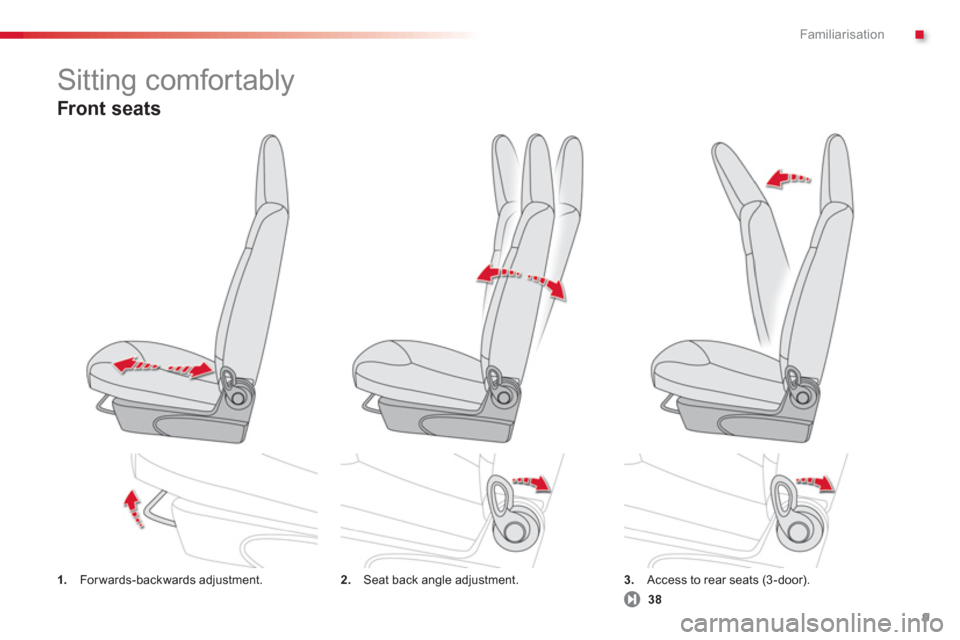
.Familiarisation
9
1. Forwards-backwards adjustment.2.
Seat back angle adjustment.3.Access to rear seats (3-door).
Sitting comfortably
Front seats
38
Page 12 of 140
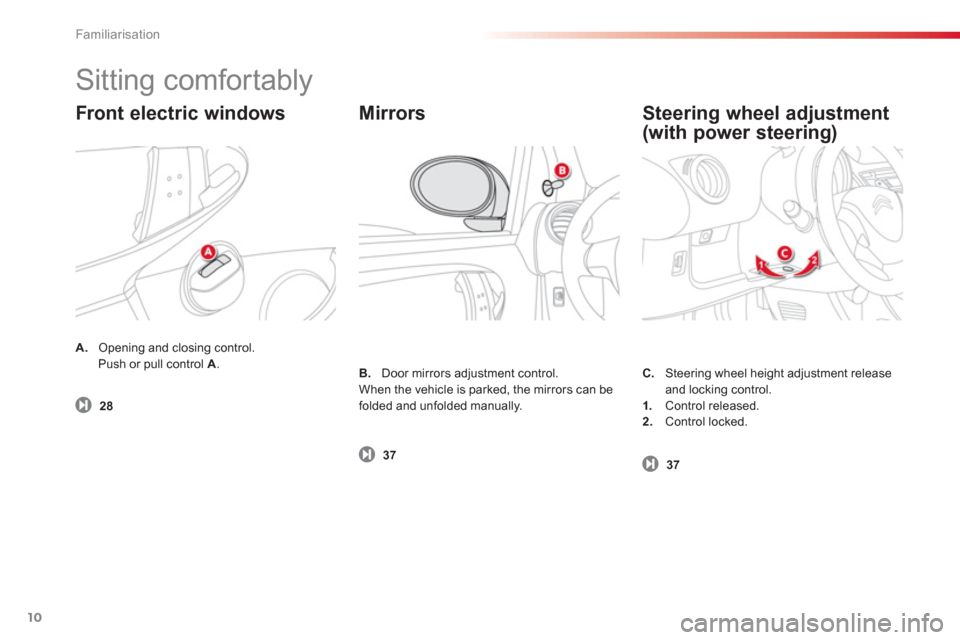
Familiarisation
10
A. Opening and closing control.
Push or pull control A .
B.
Door mirrors adjustment control.
When the vehicle is parked, the mirrors can be
folded and unfolded manually. C
.Steering wheel height adjustment release and locking control.1. Control released. 2.Control locked.
Sitting comfortably
Front electric windows
Mirrors
Steering wheel adjustment
(with power steering)
3737
28
Page 13 of 140
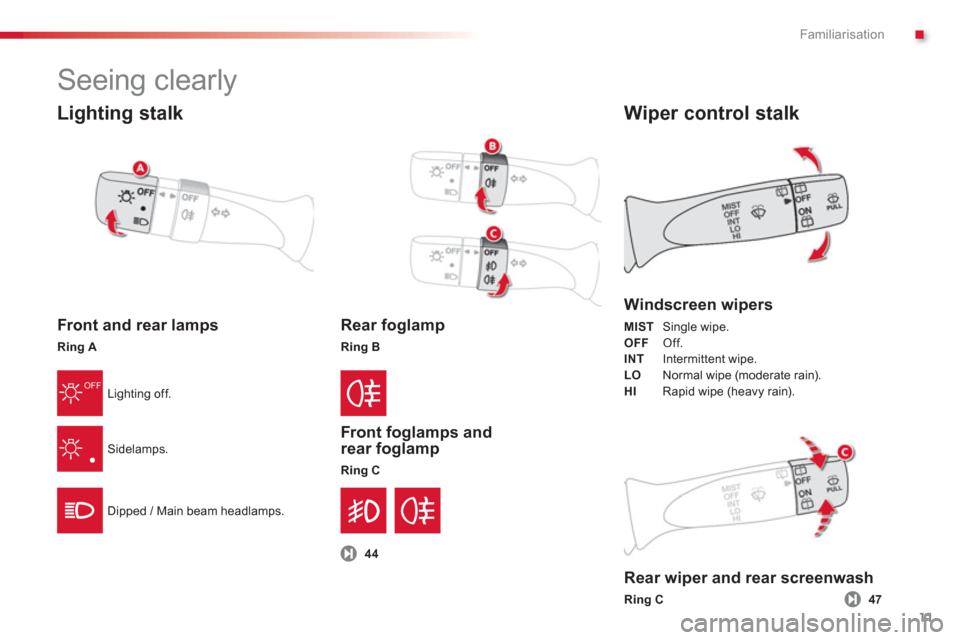
.
OFF
Familiarisation
11
Lighting stalk
Front and rear lamps
Ring A
Lighting off.
Sidelamps.
Dipped / Main beam headlamps.
Rear foglamp
Ring B
Front foglamps and rear foglamp
Ring C
Wiper control stalk
Windscreen wipers
MIST
Single wipe.
OFF
Off. INT
Intermittent wipe. LO Normal wipe (moderate rain).
HIRapid wipe (heavy rain).
Rear wiper and rear screenwash
Ring C
Seeing clearly
44
47
Page 14 of 140
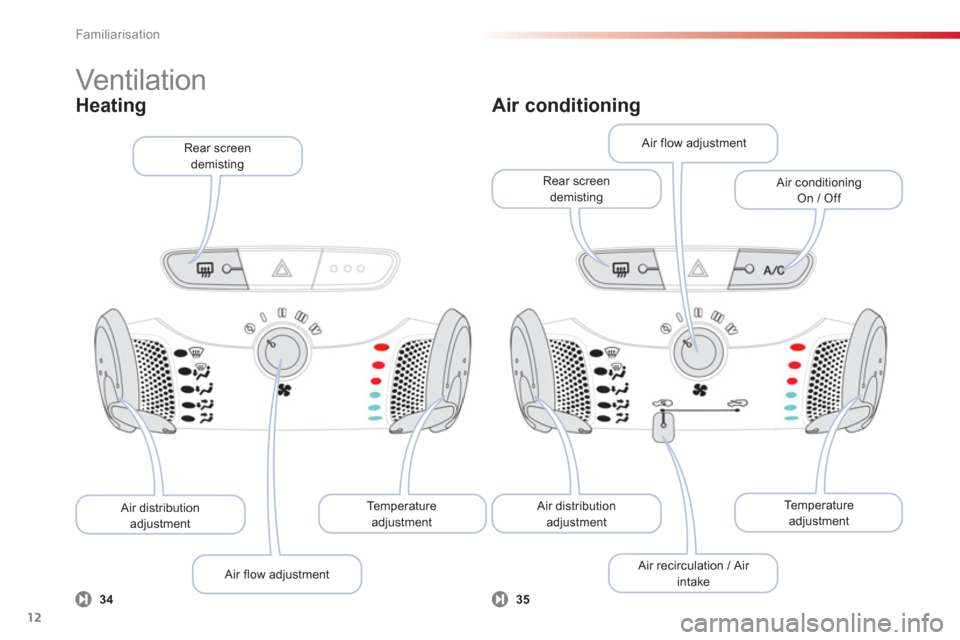
Familiarisation
12
Te m p e r a t u r e adjustment
Air flow adjustment
Air distributionadjustment
Rear screen
demisting
Air conditioning
Te m p e r a t u r e adjustment
Air recirculation / Air intake
Air distributionadjustment
Air conditioningOn / Off
Air flow adjustment
Rear screendemisting
Heating
Vent ilat ion
3534
Page 15 of 140
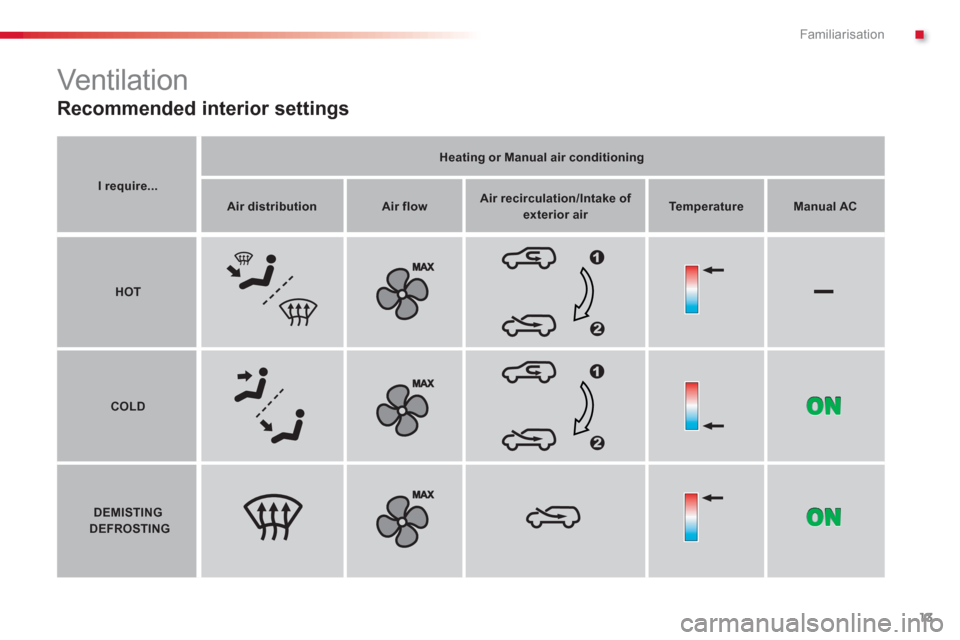
.
▬
Familiarisation
13
I require...
Heating or Manual air conditioning
Air distribution
Air flow
Air recirculation/Intake of exterior air
Temperature
Manual AC
HOT
COLD
DEMISTING DEFROSTING
Vent ilat ion
Recommended interior settings
Page 16 of 140
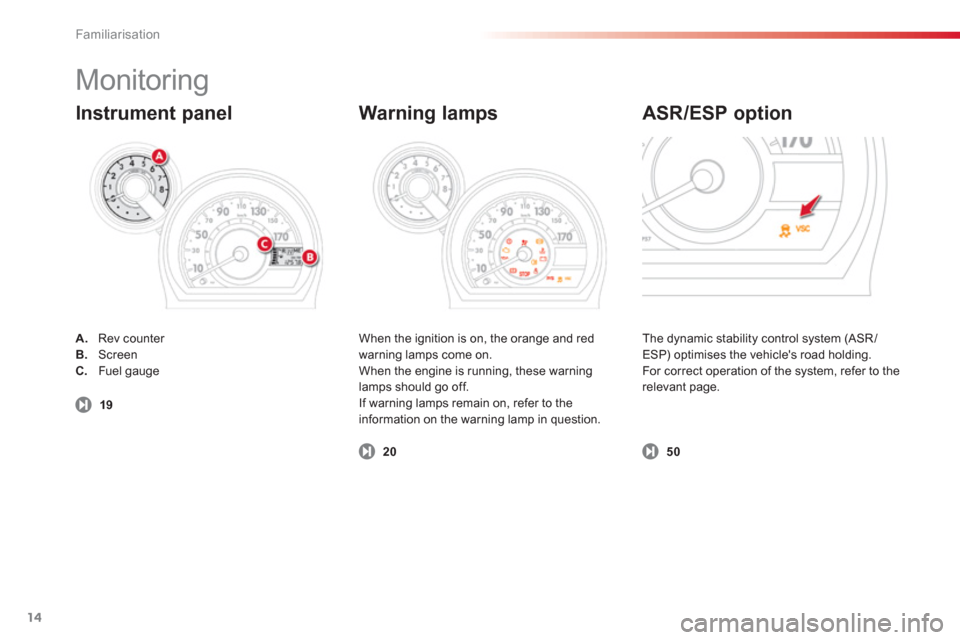
Familiarisation
14
When the ignition is on, the orange and red
warning lamps come on.
When the engine is running, these warninglamps should go off.
If warning lamps remain on, refer to the
information on the warning lamp in question.
A. Rev counter B.Screen C.Fuel gauge
The d
ynamic stability control system (ASR/ESP) optimises the vehicle's road holding.
For correct operation of the system, refer to the
relevant page.
Monitoring
Instrument panel
Warning lamps
ASR/ESP option
5020 1
9
Page 17 of 140
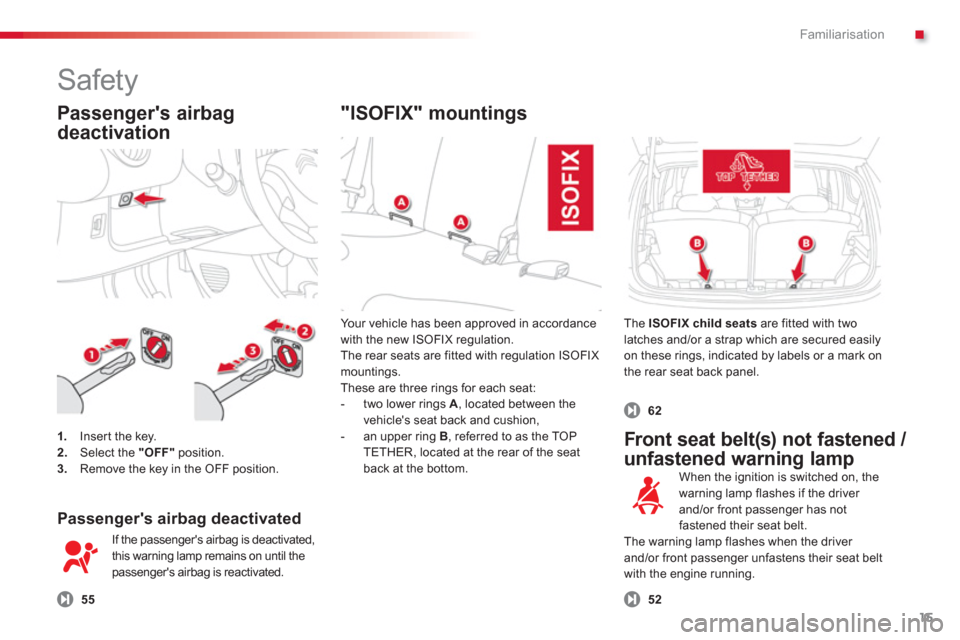
.Familiarisation
15
Your vehicle has been approved in accordancewith the new ISOFIX regulation.
The rear seats are fitted with regulation ISOFIX
mountings.
These are three rings for each seat:
- two lower rings A , located between the
vehicle's seat back and cushion,- an upper ring B
, referred to as the TOP TETHER, located at the rear of the seat back at the bottom.
The ISOFIX child seats
are fitted with two
latches and/or a strap which are secured easily on these rings, indicated by labels or a mark on
the rear seat back panel.
Passenger's airbag deactivated
If the passenger's airbag is deactivated,
this warning lamp remains on until thepassenger's airbag is reactivated.
Front seat belt(s) not fastened /
unfastened warning lamp
1.
Inser t the key. 2.Select the "OFF"
position .3.Remove the key in the OFF position.
When the ignition is switched on, the
warning lamp flashes if the driver and/or front passenger has not fastened their seat belt.
The warning lamp flashes when the driver
and/or front passenger unfastens their seat belt
with the engine running.
Safety
Passenger's airbag
deactivation"ISOFIX" mountin
gs
556
2
52
Page 18 of 140
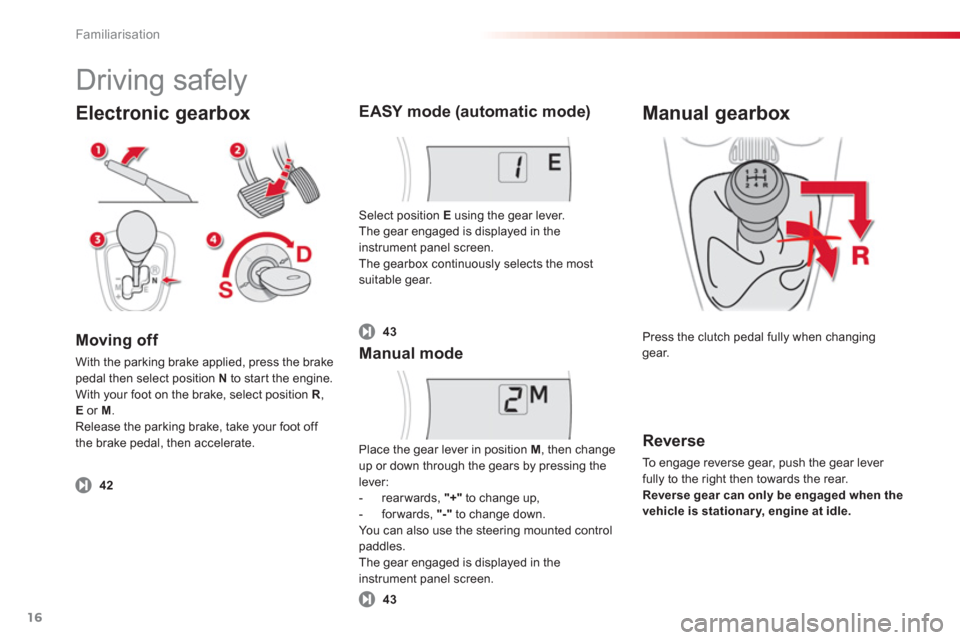
Familiarisation
16
Electronic gearbox
Moving off
With the parking brake applied, press the brakepedal then select position N to star t the engine.
With your foot on the brake, select position R , Eor M.Release the parking brake, take your foot off
the brake
pedal, then accelerate. Select position
Eusing the gear lever.
The gear engaged is displayed in the
instrument panel screen.
The gearbox continuously selects the most
suitable gear.
Manual mode
Press the clutch pedal fully when changinggear.
Reverse
To engage reverse gear, push the gear lever fully to the right then towards the rear. Reverse gear can only be engaged when the vehicle is stationary, engine at idle.
Driving safely
EASY mode (automatic mode)Manual gearbox
43
43
42
Place the gear lever in position M
, then changeup or down through the gears by pressing the lever:
- rearwards, "+"to change up,
- forwards, "-"to change down.
You can also use the steering mounted control
paddles.
The
gear engaged is displayed in the
instrument panel screen.
Page 19 of 140
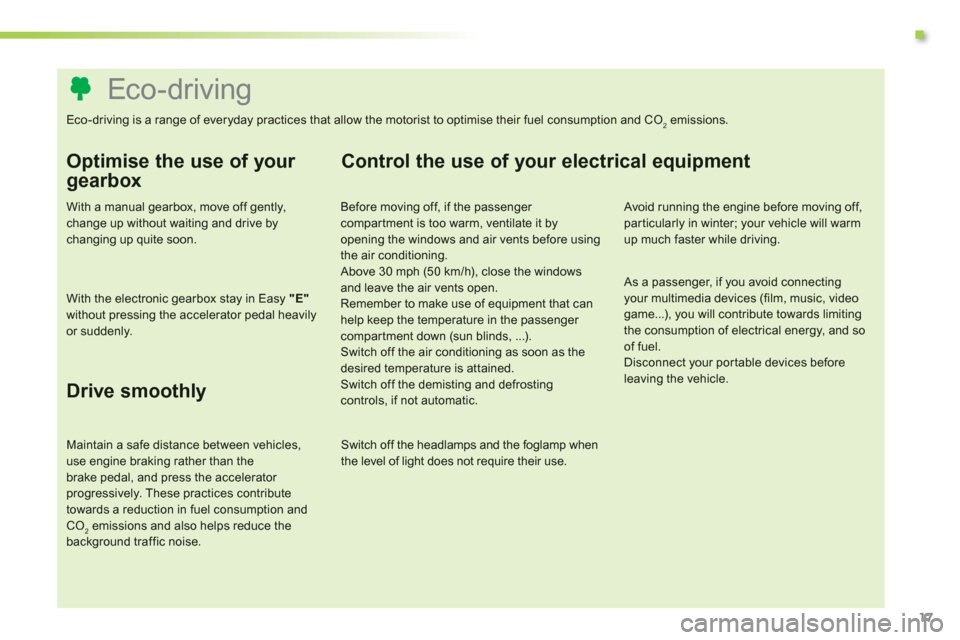
.
17
Eco-driving
Eco-driving is a range of everyday practices that allow the motorist to optimise their fuel consumption and CO2 emissions.
Optimise the use of your
gearbox
With a manual gearbox, move off gently, change up without waiting and drive by changing up quite soon.
With the electronic gearbox stay in Easy "E"without pressing the accelerator pedal heavily or suddenly.
Drive smoothly
Maintain a safe distance between vehicles, use engine braking rather than the brake pedal, and press the accelerator progressively. These practices contribute towards a reduction in fuel consumption and CO2 emissions and also helps reduce the
background traffic noise.
Control the use of your electrical equipment
Before moving off, if the passenger compartment is too warm, ventilate it byopening the windows and air vents before using the air conditioning.
Above 30 mph (50 km/h), close the windowsand leave the air vents open. Remember to make use of equipment that canhelp keep the temperature in the passenger compartment down (sun blinds, ...).Switch off the air conditioning as soon as the desired temperature is attained.Switch off the demisting and defrosting controls, if not automatic.
Switch off the headlamps and the foglamp whenthe level of light does not require their use.
Avoid running the engine before moving off,particularly in winter; your vehicle will warmup much faster while driving.
As a passenger, if you avoid connecting your multimedia devices (film, music, video game...), you will contribute towards limitingthe consumption of electrical energy, and soof fuel.
Disconnect your por table devices beforeleaving the vehicle.
Page 20 of 140
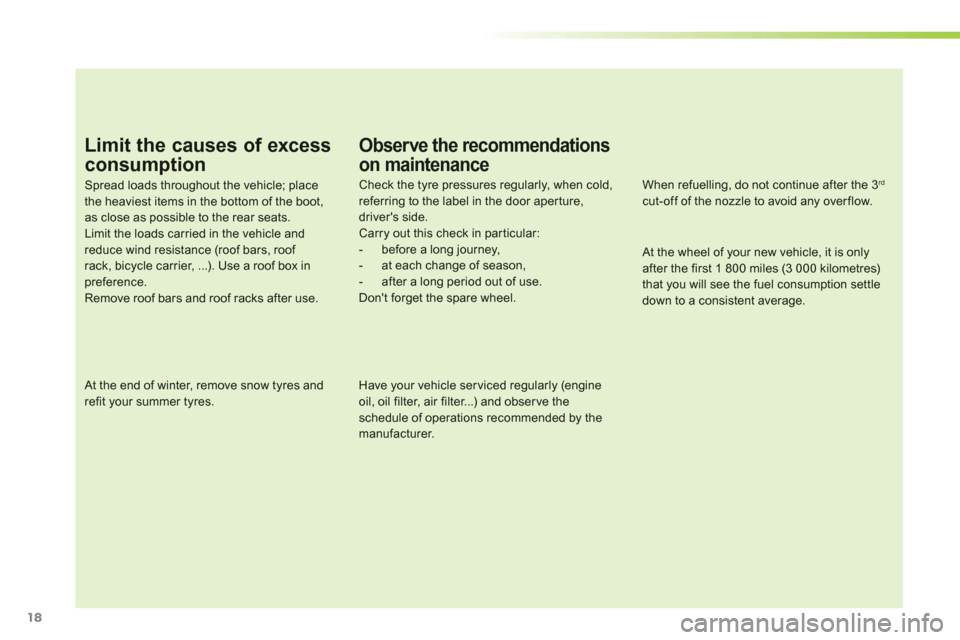
18
Limit the causes of excess
consumption
Spread loads throughout the vehicle; placethe heaviest items in the bottom of the boot,as close as possible to the rear seats.Limit the loads carried in the vehicle andreduce wind resistance (roof bars, roof rack, bicycle carrier, ...). Use a roof box inpreference.Remove roof bars and roof racks after use.
At the end of winter, remove snow tyres and refit your summer tyres.
Observe the recommendations
on maintenance
Check the tyre pressures regularly, when cold, referring to the label in the door aper ture, driver's side.
Carry out this check in par ticular:
- before a long journey,
- at each change of season,
- after a long period out of use.
Don't forget the spare wheel.
Have your vehicle ser viced regularly (engine oil, oil filter, air filter...) and obser ve the schedule of operations recommended by themanufacturer.
When refuelling, do not continue after the 3rd
cut-off of the nozzle to avoid any overflow.
At the wheel of your new vehicle, it is onlyafter the first 1 800 miles (3 000 kilometres) that you will see the fuel consumption settle down to a consistent average.